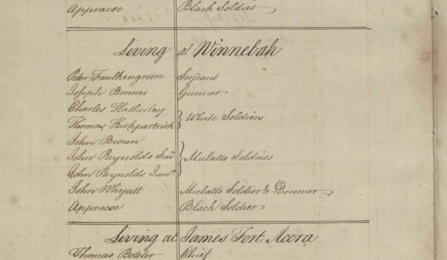Back

Collections
Britain, Royal African Company 1694-1743
These records are part of The National Archives' T 70 series Company of Royal Adventurers of England Trading with Africa and successors. They contain the names of thousands of individuals who travelled on board the Royal African Company's ships to and from Africa, as well as the names of those who lived and died at the numerous company forts.

- Date range
- 1694-1743
- Records
- 55,954
- Images
- 1,493
About this collection
The Royal African Company was a mercantile company from 1660 until it was dissolved in 1750. The company was first incorporated as the Company of Royal Adventurers Trading to Africa. Then it was reconstituted in 1672 as the Royal African Company of England. The Royal African Company held a monopoly over trade in West Africa. Until the 1730s, the company participated mainly in the slave trade to the British colonies. The Royal African Company was a crucial part of the transatlantic slave trade. It was a system that enslaved millions of African men, women, and children over several centuries. After years of campaigning for the abolition of slavery, the slave trade was abolished in Britain in 1807, and in most British colonies in 1833.
Since its formation, the Royal African Company established forts and trading posts along the African coast. The company set up its headquarters at Cape Coast Castle on the Gold Coast (modern-day Ghana). They brought traders, merchants, miners, carpenters, native interpreters, and even distillers to build their forts and African trading posts. You will also find the names of thousands of British soldiers who travelled with the company in this collection. From Africa, the company brought enslaved men, women, and children to the colonies, as well as gold, wax, and ivory. After the Royal African Company lost its monopoly of the slave trade, it focused its attention on the ivory and gold markets.
“Race” field
These archives record racial categorisation for hundreds of the people mentioned. Please note that the terms used in these documents reflect attitudes and language at the time and will now be often considered derogatory or offensive.
The transcripts reflect the 17th and 18th century’s practice of describing non-white European individuals as ‘black’, ‘negro’, or ‘mulatto’. The transcripts will not include a race field if it was not explicitly noted in the original records.
Researchers may use the Race field to find those individuals identified in the transcripts as ‘black’, ‘negro’, or ‘mulatto’. Note that we have standardised the spelling of ‘mulatto’, which is spelt in various different ways in the original records. The original records contain all three of the foregoing terms and, while the distinction between black and mulatto is generally adhered to, sometimes the terms are used interchangeably – the same person may be described as mulatto and black/negro in different records.
Not all black or mulatto individuals are described as such – sometimes the records (or the transcripts) are silent in this respect. Therefore, it’s useful to search for someone by name and by using the race search field without a name to ensure all references to that individual are retrieved.
- The National Archives, Kew, London, UK
Try the Social History Archive.